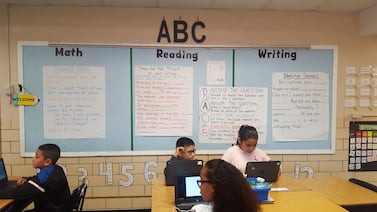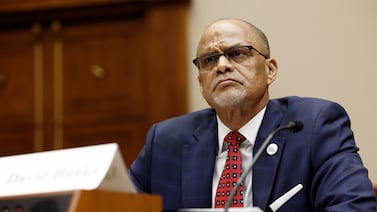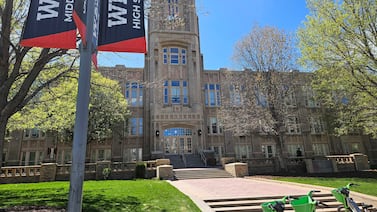Many of the more than a dozen tax measures Colorado school districts put on the ballot for the Nov. 7 election are intended to fund teacher and staff salary increases that officials say are urgently needed.
District leaders say they are facing budget crunches from various factors such as drops in enrollment and an end to federal COVID-relief funding. Some districts say they’re having a hard time hiring enough teachers and keeping them.
Alan Kaylor, superintendent of the Weld Re-8 school district in Fort Lupton, said his district started this school year with 18 vacancies out of about 210 certified teachers.
That’s more than in the past, he said.
“It used to be in special education, math, science, but it’s kind of across the board right now,” Kaylor said. “It’s hard to recruit teachers.”
School districts around the metro area have been raising salaries. In Westminster, the school district raised starting pay to $61,000 this year. According to the Colorado Education Association, 30 unions have won an 8% or higher raise this year. A few districts, including Aurora and Sheridan, have struggled to negotiate raises.
Weld Re-8 is asking voters to approve a $4 million mill levy override and a $70 million bond request. For at least the first year, the measures would not cost homeowners any more in property taxes. The bond issue would go to funding building upgrades, but the mill levy override would help raise the starting salary for teachers from $45,000 to $52,000.
Kaylor said that even though Re-8 is considered a rural district, with about 2,500 students, it borders larger urban districts including St. Vrain Valley School District, where the starting salary for teachers is $56,000. On top of that, he said, houses in the community are priced in the $500,000 range, similar to the metro areas.
“My teachers are locked out from that market,” Kaylor said. “We don’t have many multifamily units either. Those tend to be filled. Most of my teachers live out on that I-25 corridor. They drive right through St. Vrain to get here.”
Re-8 is growing in enrollment, one of few districts in the state that is. But Kaylor said other budget issues coming up are related to the end of COVID relief funding.
The relief money wasn’t used in his district to fund teacher salaries, but he did use it to pay for new support positions such as instructional coaches that may not have funding to continue next year.
Kaylor is also concerned about the upcoming cost of renewing licenses for online programs purchased during the pandemic that teachers still use and whether he’ll be able to find funding to maintain an online program the district still offers as an option for about 50 students who preferred the model.
In Englewood, another small district requesting a $4 million mill levy override, the district has had to spend down reserves, or savings, in order to increase salaries for teachers over the past few years.
The Englewood district, south of Denver, has had a drop of more than 11% in enrollment in the last five years.
If the measure is approved, the district already negotiated an increase of 5% for teachers and a minimum increase of 7.5% for classified staff, both effective Jan. 1.
Englewood’s tax request would not increase property taxes for homeowners because the measure would simultaneously lower the taxes for the bond approved in 2016.
In Douglas County, the district is trying a second year in a row to ask voters for a mill levy tax measure. The $66 million mill levy override would pay for teacher raises. Last year, the same measure failed by less than 1% of the vote.
Superintendent Erin Kane said average salaries for teachers in the Douglas County school district are $19,000 less than in neighboring districts. It has meant more vacancies at the start of the school year.
At one elementary school, a teacher who took another job elsewhere over the summer was not able to be replaced in time for the school year to start. The school had to combine three second grade classrooms into two, with 33 students each.
“That’s the very real impact,” she said.
In talking to the community about the need for the measure this year, Kane said that voters understand that teachers deserve a raise, and that a teacher hired at $45,209 — the current starting salary — can’t afford living in Douglas County.
“It’s a shift in our community,” Kane said, of having more teachers commuting into the district for work.
But the challenge, she said, is helping voters understand how Colorado school districts are funded.
“Our community is under the impression that since their local property taxes are going up that their schools would be benefiting from that,” Kane said. “Higher local property taxes just means less money from the state.”
Colorado runs a formula that dictates how much money each district should have per student. The money comes first from local property taxes, and then the state fills in the gap, to get the funding to what the formula says it should be. Districts get more money than the formula says they should only when voters approve local tax measures that are on top of the regular property taxes.
In Douglas County, Kane tells voters the district is getting $2,000 less per student than neighboring districts because of those local measures, meaning the salaries she can offer are less competitive.
“I would have told you last year it was urgent,” Kane said. “This year it’s a crisis.”
Yesenia Robles is a reporter for Chalkbeat Colorado covering K-12 school districts and multilingual education. Contact Yesenia at yrobles@chalkbeat.org.







